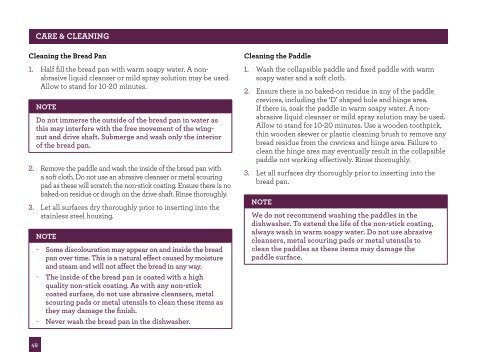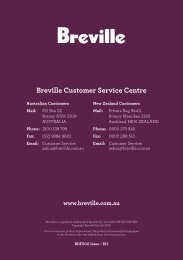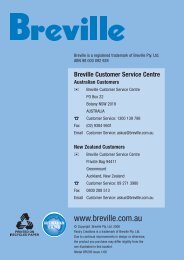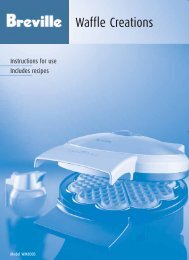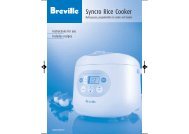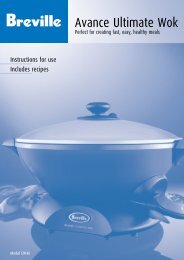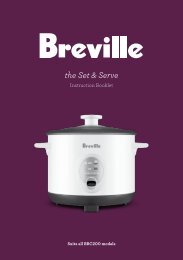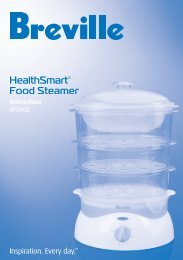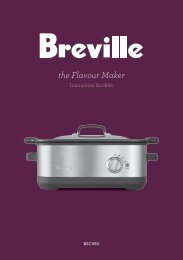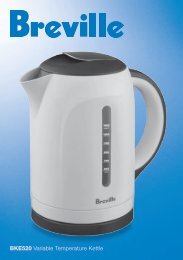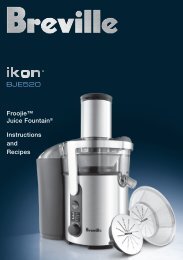the Custom Loaf - Breville
the Custom Loaf - Breville
the Custom Loaf - Breville
You also want an ePaper? Increase the reach of your titles
YUMPU automatically turns print PDFs into web optimized ePapers that Google loves.
48<br />
CARE & CLEANING<br />
Cleaning <strong>the</strong> Bread Pan<br />
1. Half fill <strong>the</strong> bread pan with warm soapy water. A nonabrasive<br />
liquid cleanser or mild spray solution may be used.<br />
Allow to stand for 10-20 minutes.<br />
NOTE<br />
Do not immerse <strong>the</strong> outside of <strong>the</strong> bread pan in water as<br />
this may interfere with <strong>the</strong> free movement of <strong>the</strong> wingnut<br />
and drive shaft. Submerge and wash only <strong>the</strong> interior<br />
of <strong>the</strong> bread pan.<br />
2. Remove <strong>the</strong> paddle and wash <strong>the</strong> inside of <strong>the</strong> bread pan with<br />
a soft cloth. Do not use an abrasive cleanser or metal scouring<br />
pad as <strong>the</strong>se will scratch <strong>the</strong> non-stick coating. Ensure <strong>the</strong>re is no<br />
baked-on residue or dough on <strong>the</strong> drive shaft. Rinse thoroughly.<br />
3. Let all surfaces dry thoroughly prior to inserting into <strong>the</strong><br />
stainless steel housing.<br />
NOTE<br />
− Some discolouration may appear on and inside <strong>the</strong> bread<br />
pan over time. This is a natural effect caused by moisture<br />
and steam and will not affect <strong>the</strong> bread in any way.<br />
− The inside of <strong>the</strong> bread pan is coated with a high<br />
quality non-stick coating. As with any non-stick<br />
coated surface, do not use abrasive cleansers, metal<br />
scouring pads or metal utensils to clean <strong>the</strong>se items as<br />
<strong>the</strong>y may damage <strong>the</strong> finish.<br />
− Never wash <strong>the</strong> bread pan in <strong>the</strong> dishwasher.<br />
Cleaning <strong>the</strong> Paddle<br />
1. Wash <strong>the</strong> collapsible paddle and fixed paddle with warm<br />
soapy water and a soft cloth.<br />
2. Ensure <strong>the</strong>re is no baked-on residue in any of <strong>the</strong> paddle<br />
crevices, including <strong>the</strong> ‘D’ shaped hole and hinge area.<br />
If <strong>the</strong>re is, soak <strong>the</strong> paddle in warm soapy water. A nonabrasive<br />
liquid cleanser or mild spray solution may be used.<br />
Allow to stand for 10-20 minutes. Use a wooden toothpick,<br />
thin wooden skewer or plastic cleaning brush to remove any<br />
bread residue from <strong>the</strong> crevices and hinge area. Failure to<br />
clean <strong>the</strong> hinge area may eventually result in <strong>the</strong> collapsible<br />
paddle not working effectively. Rinse thoroughly.<br />
3. Let all surfaces dry thoroughly prior to inserting into <strong>the</strong><br />
bread pan.<br />
NOTE<br />
We do not recommend washing <strong>the</strong> paddles in <strong>the</strong><br />
dishwasher. To extend <strong>the</strong> life of <strong>the</strong> non-stick coating,<br />
always wash in warm soapy water. Do not use abrasive<br />
cleansers, metal scouring pads or metal utensils to<br />
clean <strong>the</strong> paddles as <strong>the</strong>se items may damage <strong>the</strong><br />
paddle surface.


